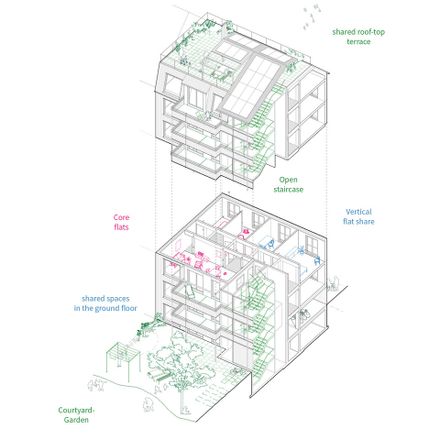Abakus Co-Housing
ARCHITECTS
Stereo Architektur
FIRE PROTECTION
Indermühle Bauingenieure
LEAD ARCHITECTS
Jonathan Hermann, Claudio Meletta, Martin Risch, Henrik Mansson
ELECTRICAL PLANNING
Elektro Brodbeck Ag
BUILDING PHYSICS
Grolimund Und Partner Ag
BUILDING SERVICES ENGINEER
Ingenieurbüro Markus Stolz
CIVIL ENGINEER
Wam Planer Und Ingenieure Ag
ENERGY
Grolimund Und Partner Ag
CLIENT
Genossenschaft Mietshäuser Syndikat, Basel
TIMBER ENGINEER
Indermühle Bauingenieure
PHOTOGRAPHS
Daisuke Hirabayashi
YEAR
2021
LOCATION
Basel, Switzerland
CATEGORY
Coliving
ARCHITECTURE CHALLENGED BY THE PRESENT.
The project does not begin with a typical building programme or a set of technical specifications, but with a vision of communal living and our aspiration to create forward-looking and environmentally sustainable architecture.
It also begins with an opportunity - a small-scale urban development that makes participatory urban development possible. And it begins as part of a political cooperative movement that understands housing as a basic need and not as an object of speculation.
We embrace that our role as architects is extended by these pre-conditions. The questions become broader, the involvement deeper. New thematic fields open up and are pursued over a longer period of time.
In the architectural implementation, we can draw from the multifaceted nature of the content. This provides the project with depth and makes it full of life.
A COLLECTIVE PROJECT FROM THE VERY BEGINNING.
At the origin of house Abakus lies a vision of urban housing, and community.
The future inhabitants and the architects are involved all along, while the cooperative Mietshäuser Syndikat Basel provides the institutional framework.
In a triangle of future inhabitants, architects, and cooperatives, the project is being developed as a response to an open call issued by the Habitat Foundation.
Set on a former industrial site, small-scale building plots around a shared courtyard encourage small groups of people to participate in urban development.
The initiators of house Abakus continuously develop the concept while taking a stand on current ecological, social, and housing policy issues. This leads to the following main ideas, ultimately finding a physical shape in the actual architecture.
- Inhabitants should be able to stay in their home, even if their family situation changes and their demand for space evolves. Accordingly, the size of the housing units should be easily adaptable with no need for construction work.
- Cooperative housing should be affordable and accessible and thus open to a broad spectrum of people. Not only families and couples, but also singles, students, and refugees should be able to find a home in the house.
- The house should be designed climate-friendly and straightforward. It therefore will be carried out as a timber construction and at the same time be reduced to the essentials.
- Outdoor spaces are shared living spaces. They are all connected and serve to benefit both people and biodiversity.
COMBINING WAYS OF LIVING CREATES GREATER BENEFITS FOR ALL.
In order to allow for flexibility in the residential units and thus avoid the need to hoard living space, two different forms of living to complement each other in the building: On the one hand, horizontally expandable core flats. And on the other hand, a vertically organised flat-sharing community. The core flats offer a long-term perspective for groups of two or more people.
The flat-share offers a place for people who from experience can rarely enjoy the benefits of cooperative housing, such as students or refugees.
At the same time, their natural fluctuation periodically offers the opportunity to adjust the sizes of the core flats, for example, if an additional children’s room is needed.
This way, a 3.5- room flat can be expanded up to a 5.5-room flat, while the flat-share can consist of up to 10 single rooms.
However, the boundaries between the living forms are not static but can blur and overlap across the different rooms and floors.
In this way, the two forms of living are mutually beneficial, allowing flexibility, creating accessible living space, accommodating a variety of living situations, and promoting social mixing. Last but not least, this creates a strong sense of identification and pleasant warmth of interpersonal relations.





















